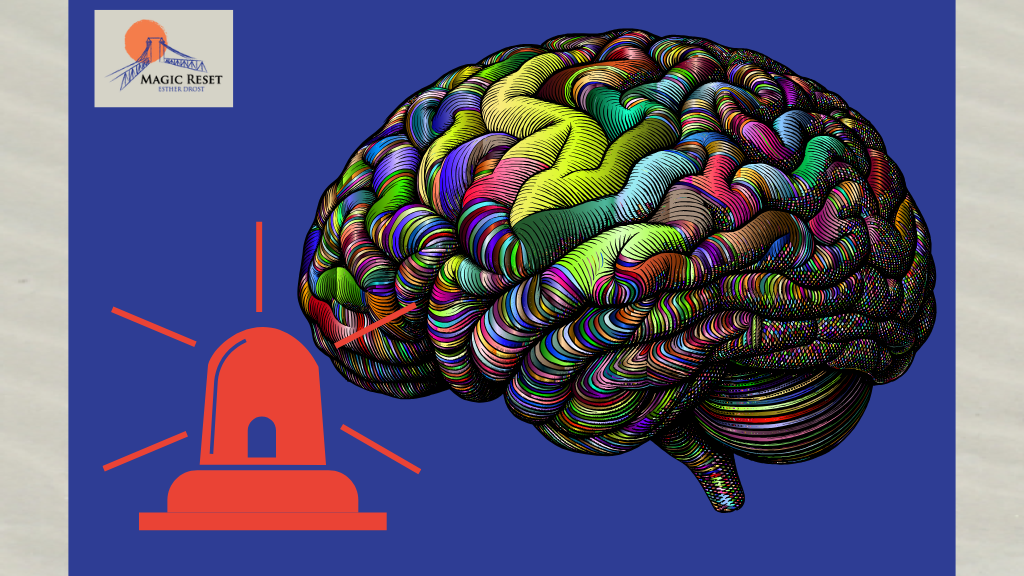The false alarm of the brain is something that can actually generate real physical pain, which is called neuroplastic pain. Our brains are wired to protect us and pain is an alarm signal that something is wrong or that the body is in danger. When you get an injury, for instance you break your ankle, the brain creates pain so that you stop using your ankle. This is needed so that we have it checked and take care of the ankle before we create more damage to it. This is really useful from the brain. Unfortunately, sometimes the brain is making a mistake in interpreting signals. When that happens, the brain can reacts similiar as with the ankle and can create physical pain.
What is neuroplastic pain?
Neuroplastic pain is pain that has been learned by the brain over time. Imagine an occasion years ago where a nerve signal has been misinterpreted and that instead of classifying it as a SAFE message, the brain has filed it as DANGER. With danger around, the brain can generate physical symptoms like increased heart rate, sweating and also physical pain.
What is important to understand is that every second there are around 2 million bits of information coming to us which the unconscious brain takes in. Yet the conscious brain can only absorb about 200 of that. This means that every second, the brain makes a choice in interpreting signals it gets. Similar signals it has gotten before, will be treated the same way. So, if a certain signal has been misinterpreted, it will easily happen again and hence the same incorrect reaction upon it will take place too. If at the time that was pain, it will generate pain on each subsequent response.
This is called neuroplastic pain: pain that has been learned by the brain.
Examples of neuroplastic pain
An example of neuroplastic pain is often related to pain somewhere in the body without apparent injury or strain. Imagine you had a broken ankle years ago, the injury has healed already a long time ago. When you break your ankle, the body usually needs around 6 weeks to heal the bone. It does that all by itself isn’t that amazing! After the injury has healed, the ankle should not give anymore pain. If you would experience pain in an area without a new injury or strain this might indicate that the pain is neuroplastic.
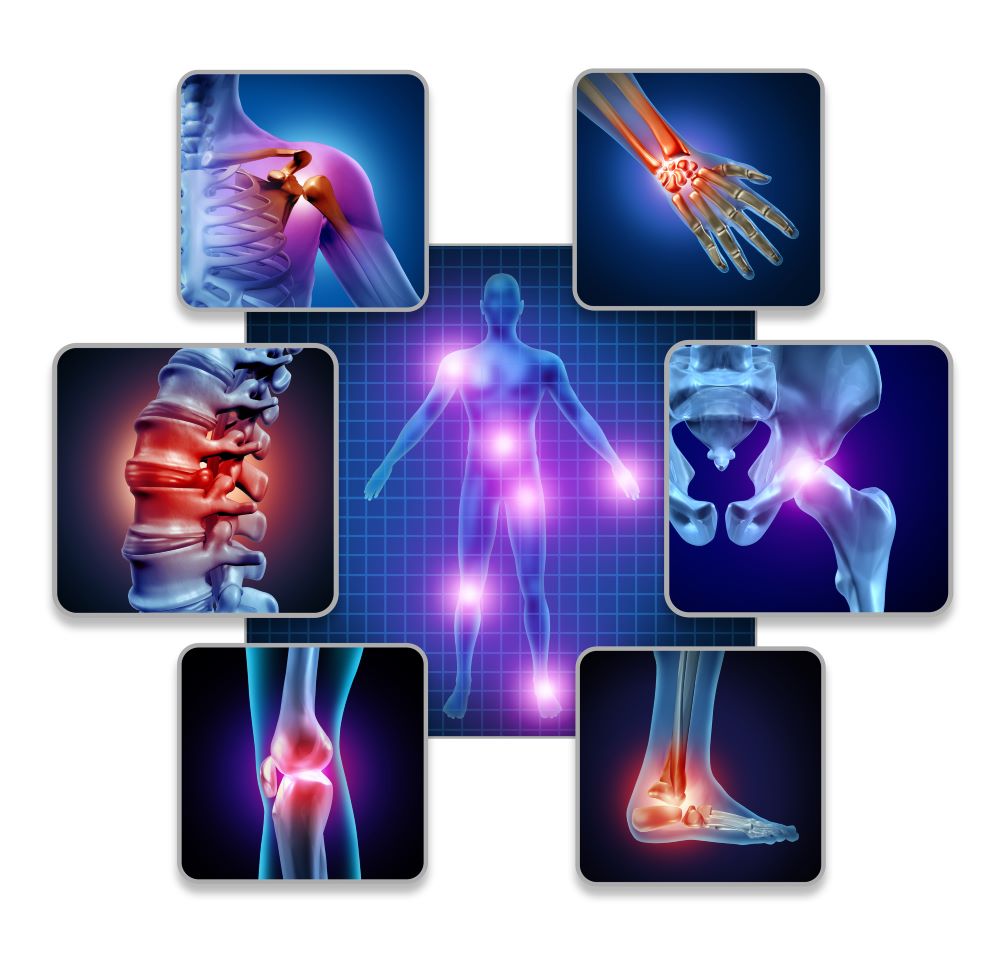
A second example of neuroplastic pain is that it is often moving around in the body. The pain is inconsistent; you’ll get it at a specific spot for a couple of weeks or months and then it shifts to another part of the body to sit there for a while.
Another example of neuroplastic pain is that intensity levels tend to change. It can happen that in the morning you have no pain but as the days goes by, the pain is getting worse. Other people have it the other way around: they get pain when getting up and gets better during the course of the day.
A final example is about activities that normally should not trigger physical pain, like the weather or specific places. The brain can associate these with pain, so the next time you have that weather condition or are at that specific spot, the brain can create fear as it believe there’s danger. To protect us from the danger, the brain triggers neuroplastic pain. The more often this happens, the more conditioned the reaction will be.
Can neuroplastic pain be caused by stress?
Neuroplastic pain can absolutely be caused by stress. When you have long periods of stress and tension, like problems at work or relationship tensions, your brain may be in a state of high alarm for most of the time.
A permanent state of vigilance creates a high pressure on the autonomous nervous system. The consequence is that it can cause a general feeling of fear and danger; the brain can overreact in this state and trigger pain symptoms like headaches, tension in shoulders and back pain.
In a period of stress, the hormone cortisol is being released by the brain. Normally, after the stressful event is over, the same hormone makes sure you can go into a state of rest and repair. However, if the period of stress lasts too long, the brain is a constant ‘overdrive’-mode and this is how neuroplastic pain is developed. Be aware of this stress and deal with it straight away instead of letting it cumulate over time. You can find free ressources here to reduce stress.

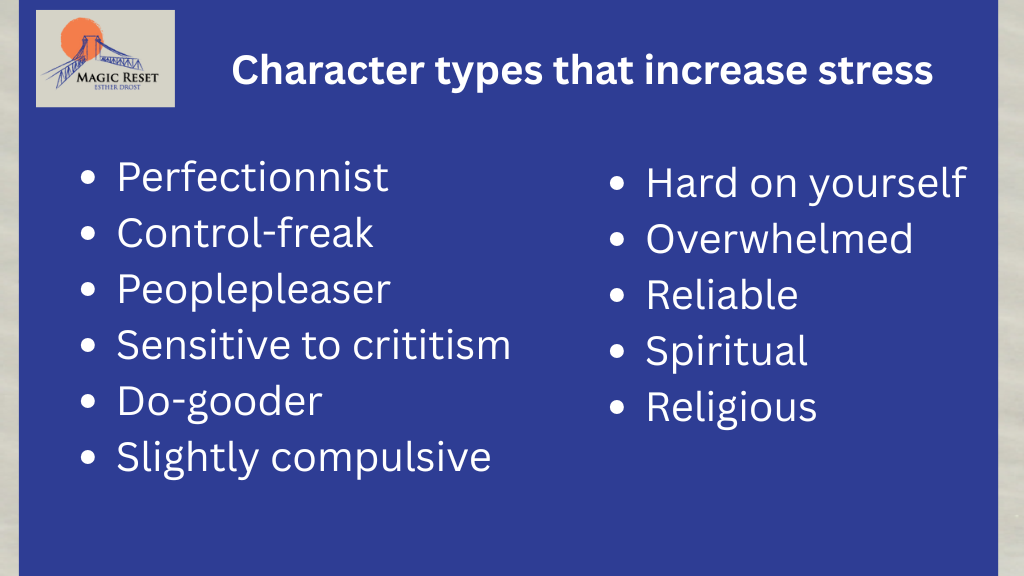
Does character type adds to stress?
Your character can also play a role in being more prone to neuroplastic pain. There are 11 character types that contribute to stress (see picture) as these types tend to put constant pressure on oneself. These can be pressures of wanting to be good or wanting to do the right thing. The result of all these pressures is often that one feels chronically unsafe as it is never finished and never good enough. If you are a perfectionist, you are very prone to chronic pain; read more about it here.
Can neuroplastic pain be caused by trauma?
Neuroplastic pain can definitely be caused by trauma. There are many situations that a person can have gone through over the course of their life in which they felt unsafe, for instance bullying or abuse. The same goes for children that have survived physical, psychological or sexual trauma. If those experiences have not been healed, they can sense chronic danger and danger triggers physical symptoms by the brain.
A stressful event in a child’s life is called an Adverse Childhood Experience (ACE). There are numerous studies that have measered these.
Did you know that approximately 1 in 4 children have at least experienced 1 ACE in their life? There are also studies that state 1 in 5 children have experienced 3 ACE’s or even more! All these negative childhood events have a huge impact on their mental and physical health.
Research shows that they are more likely to develop neuroplastic pain as their brains have been in an over-reactive state for too long and their autonomic nervous system is deregulated which can trigger the brain in amplifying the symptoms.
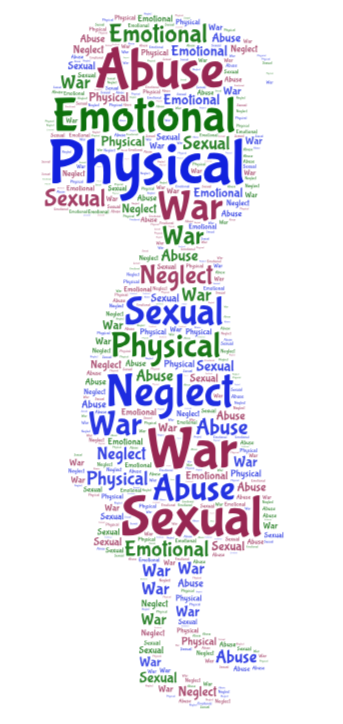
Normally after a stressful event the brain will go back to a calm state where it can rest and repair. But if the brain gets stuck in the alarm-state and is not getting out of it, this can perpetuate the symptoms. Many people that are still in this state as if it has happened yesterday, they suffer chronic pain like chronic fatigue and anxiety.
Can a herniated disc give neuroplastic pain?
To be able to tell if a herniated disc is the cause of neuroplastic pain, it requires some investigation. A diagnosis can be very helpful if it is 100% sure that the structural abnormality like a herniated disc is the cause of the pain. It would seem logical that a herniated or degenerated disc is the cause of back pain. You experience pain in that area, via a scan or MRI you find a structural abnormality so there you go, found the cause of the pain.
However, the truth shows a totally different story!
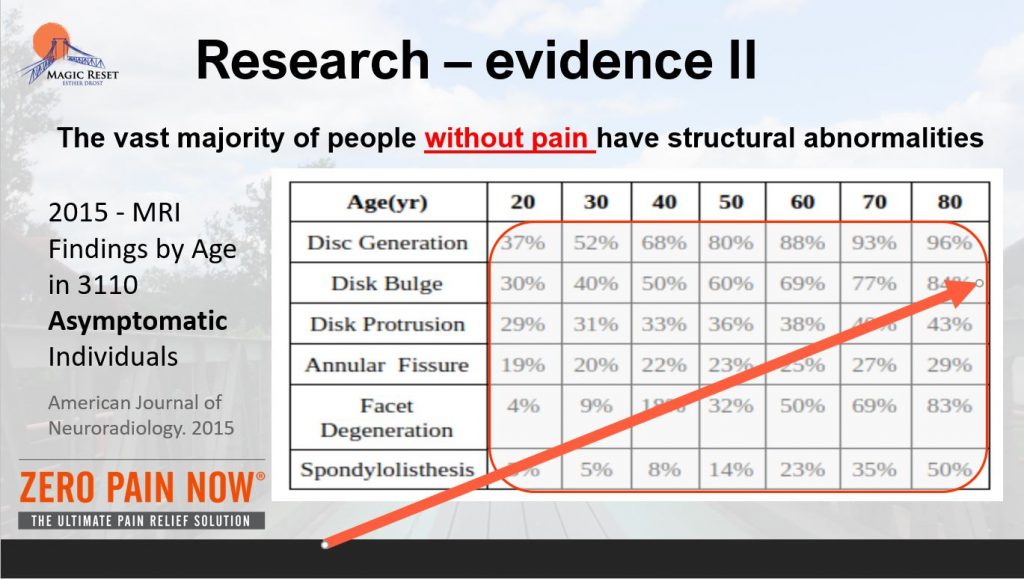
There are many people with herniated discs that have never had any back pain! So how can a herniated disc for one person be the cause of pain, while for other persons having the same herniations, do not have pain at all??
Did you know that the older you get, the more herniations you will find on scans? They are increasing with age.
Structural abnormalities seem more to be a normal sign of aging.
The person with pain can identify himself with this diagnosis and that is not always helpful, especially in the case of herniated or degenerated discs. They often have the feeling their body is broken which increases fear and frustration and triggers emotional danger to which the brain will react with amplification of symptoms. If all solutions offered by the medial world are not being successful, it is interesting to investigate other factors of their pain, like character types and stress in one’s life. This can reveal the real cause of pain and that the pain is neuroplastic. Which is great news basically as that means this can be undone.
How to resolve neuroplastic pain?
How neuroplastic pain can be solved is a path that is different for each individual. Although there are few doctors and therapists in the world that are specialized in this area, more and more coaches can be found that can help find the sources of stress. They will put another light on the diagnoses and show the way how to eradicate pain. Neuroplastic pain is also often called a Mind-Body disorder.
First of all, it is important to understand the working of the brain and figure out for yourself if your pain is neuroplastic pain. If that is the case, you can analyze if you have experienced trauma in your life and if stress plays a high role. As seen above, stress can also come from specific character types. Read more about how to reduce stress in this blog.

